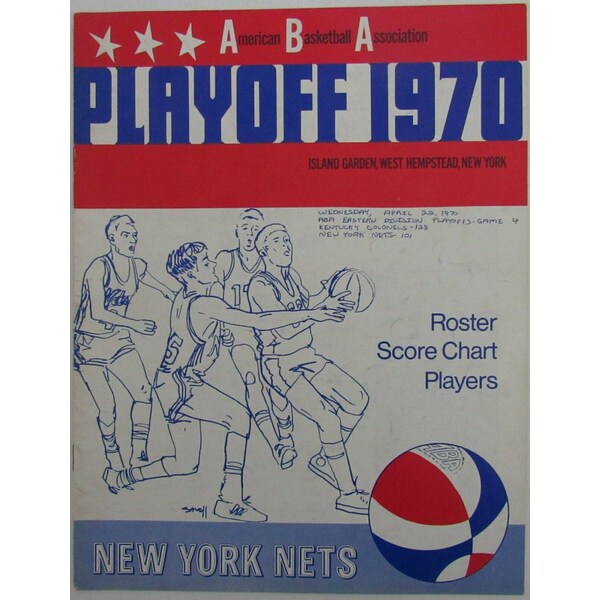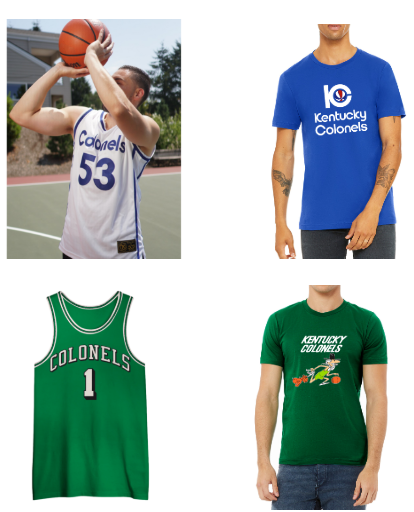American Basketball Association (1967-1974)
Tombstone
Born: March 31, 19671Louisville Gets ABA Franchise, UPI via the (Toledo) Blade, April 1, 1967, p16
Folded: June 17, 1976, ABA merged with NBA2Colonels Franchise in Doubt, AP via the Kentucky Era, June 16, 1976
First Game: October 14, 1967 (L 117-95 @ Indiana Pacers)
Last Game: May 28, 1976 (L 131-111 @ Denver Nuggets, Game 7, ABA Championship Semifinals)
ABA Championship: 1975
Arena
Louisville Gardens (1967–1970)
Opened: 1905
Freedom Hall (1970–1976)
Opened: 1956
Branding
Team Colors:
- 1967-1970: Green, Black, White
- 1970-1974: Blue, White
- 1974-1976: Blue, White, Red
Ownership
Owners:
- 1967-1969: Joseph E. Gregory, Mamie Gregory, and William C. Boone
- 1969-1973: H. Wendell Cherry, Bill DeWitt, Stuart Jay, David Jones, John Y. Brown, Jr., and Mike Storen
- 1973-1976: John Y. Brown, Jr. and Ellie Brown
Background
The Kentucky Colonels were the 11th and final charter franchise awarded by the American Basketball Association (ABA) in 1967. While Louisville was conditionally awarded a franchise in the new league on March 6, 1967, it would be a month before the owners, Joseph and Mamie Gregory, along with William Boone, were revealed and officially granted the franchise.
Hitting the Court
The group chose the nickname Colonels for their team but took a few weeks to settle on Kentucky over Louisville as the geographic designation. On October 14, 1967, they played their first game, traveling a little over 100 miles north to Indianapolis to take on the Indiana Pacers, who were also making their ABA debut.
The hometown team triumphed, 117 to 95, then spoiled the Colonels’ home opener six days later by a score of 106 to 95 in front of 10,427 fans at Freedom Hall in Louisville. Pro sports, though, was back in Louisville. The city had been without a big league team in any sport since baseball’s Louisville Colonels of the National League closed up shop in 1899.
The Colonels, in their green, black, and white uniforms, finished their first season with a record of 36 and 42, tied for fourth with the New Jersey Americans. The Colonels, though, won the tiebreaker to claim the final playoff spot in the ABA’s Eastern Division. They were eliminated in the first round by the Minnesota Muskies in five games.
Winning Ways
The Colonels bounced back, as it were, the following season and finished in third place with a record of 42 and 36. Their first winning season was quite memorable, as were some of their publicity stunts. For example, on November 27, 1968, Penny Ann Early, the first licensed female jockey, entered the game against the Los Angeles Stars. With 8:05 remaining in the first half, she replaced guard Darel Carrier with Kentucky leading 33 to 29. She had never played basketball at any level but was sent in for one play. She inbounded the ball to Bobby Rascoe, who immediately called a time-out. Early left the game but became the first woman ever to play pro basketball. Kentucky lost the game 111 to 107.
Led by Louie Dampier, the Colonels made the playoffs but fell short in the post-season, losing in seven games to their arch-rivals, the Indiana Pacers, in the division semifinals. Their winning ways continued, though, as they finished in second place in the Eastern Division the following season with a record of 45 and 39. In the first round of the playoffs, they downed the New York Nets four games to three. However, their arch-rivals dispatched them once again in the division finals. Indiana beat the Colonels in five games before capturing the league title over the Los Angeles Stars in six.
Local Hero
Things got really exciting when University of Kentucky star Dan Issel was drafted. Though he was also selected by the Detroit Pistons of the NBA, Issel opted to play for the Colonels. In his first season, he led the ABA in scoring. He averaged 29.9 points per game and grabbed 13.2 rebounds per contest. He was selected for the ABA All-Star team and shared Rookie of the Year honors with Virginia Squires guard Charlie Scott.
The Colonels also changed their color scheme that season from green, black, and white to royal blue and white. In 1974, they added red trim.
Back in Louisville, the Colonels again finished in second place, this time behind the aforementioned Virginia Squires. Propelled by Issel and Dampier, they made it to the finals but lost in seven to the Utah Stars.
The 1971-72 season saw the Colonels achieve their best record, topping the Eastern Division with an all-time, ABA-best record of 68 and 16. The New York Nets, though, spoiled the party when they eliminated the Colonels in six games in the first round of the playoffs.
Struggles at the Gate
Before the post-season began, rumors began swirling that the team was moving to Cincinnati, whose Royals had just announced their departure for Kansas City. Bill DeWitt Jr. and Brian Heekin, who were in the midst of trying to get an arena built in Cincinnati and capture an NHL expansion team, denied the reports. The two wound up being awarded a franchise in the WHA that became the Cincinnati Stingers. While the Colonels weren’t sold to the Cincinnati group, they wound up playing 10 neutral site games in the city, all at the University of Cincinnati’s Armory Fieldhouse during the 1973-74 season. Oddly, no games were played at the Royals’ former home, the Cincinnati Gardens. The Colonels didn’t play any games in Cincinnati during the 1974-75 season but returned for eight games in 1975-76, all in the new, then state-of-the-art Riverfront Coliseum.
More Stars, More Wins and a Championship
The following season, the Colonels added another young superstar named Artis Gilmore. However, the Carolina Cougars won the division as they finished just a single game ahead of Kentucky in the Eastern Division. Kentucky powered through and again made it to the finals, only to be undone in seven games by the Pacers.
The 1973-74 season was much the same. A second-place finish, this time behind the Nets, was followed by those very same Nets eliminating the Colonels in the Eastern Finals. The Colonels finally made it over the mountain in 1975.
After finishing tied for first place with the New York Nets, the Colonels were forced to play a one-game tiebreaker against the co-division champs. Kentucky prevailed 108-99 as Gilmore led the way with 22 points and 33 rebounds. The Colonels knocked off the Memphis Sounds in the division semifinals in five games, then did the same to the Spirits of St. Louis in the finals.
In the championship series, the Colonels once again faced the Pacers. This time, Kentucky found a way to finally topple their adversary as they won the 1975 ABA Championship four games to one. For Game 5, 16,622 fans jammed into Louisville’s Freedom Hall to witness the Colonels’ triumph.
For the season, the team drew over 8,000 fans a game, which doesn’t sound like a lot, but back then, NBA average attendance was only 5,000 fans per game. The Colonels and the ABA had piqued, however.
The Beginning of the End
Four days before the 1975-76 season was scheduled to tip-off, the nine surviving ABA teams (the Memphis Sounds had moved to Baltimore over the summer but soon folded) applied for membership in the NBA for the 1976-77 season. New York and Denver applied almost a month earlier, followed by the remaining seven on October 20, 1975. The NBA, which had been in talks with the ABA since 1970 about the prospect of a merger, tabled the idea.
Meanwhile, the Colonels and the ABA pressed on. Eleven games into the season, the San Diego Sails folded, followed less than a month later by the Utah Stars. With all teams now in one division, Kentucky finished in fourth place with a record of 46 and 38. They beat the Pacers in the first round of the playoffs before losing to the Denver Nuggets in the semifinals.
At the end of the season, things were looking bleak for the Colonels and the ABA. The day before Game 5 of the ABA Championship series, the Squires folded. Ten days later, the Spirits of St. Louis moved to Utah but would never play a game there. Over the next few months, as spring gave way to summer, talks continued between the ABA and NBA. In the end, only four of the six surviving teams joined the established league.
No NBA for Louisville
Colonels owner John Y. Brown felt the price to join the NBA, a reported $4.5 million, was too high and instead opted to be bought out for $3 million. He used that money to buy half of the Buffalo Braves. In 1978, Brown and his partner swapped franchises with Irv Levin, owner of the Boston Celtics.
Ozzie and Daniel Silna, owners of the Utah franchise, the former Spirits of St. Louis, opted for a buyout that famously included a stipulation that granted them a 1/7 share of the TV revenue of the four surviving teams (Denver, Indiana, New York, and San Antonio) in perpetuity. That deal lasted until 2014, when it was renegotiated.
The Colonels and the Indiana Pacers were the only two teams to play in the same city with the same name for all nine ABA seasons. Major league pro sports never returned to Louisville.
In 2001, the NBA’s Vancouver Grizzlies were looking for a new home after running into severe financial difficulty. Louisville was one of nine cities considered as a destination for the team. However, after much wheeling and dealing, Memphis was chosen on July 2 of that year.
Kentucky Colonels Shop
Our Favorite Gear
kentucky Colonels ABA Apparel
When it comes to Replica Jerseys, we turn to our friends at Royal Retros, who put extraordinary detail into their fully customizable basketball jerseys.
Free Customization Included
Each jersey individually handmade
Any name and number
Sewn tackle twill crest, numbers & letters
100% polyester
Heavyweight fabric made to game standards
Relive Louisville’s pro basketball days in a jersey or T-Shirt, or both, from Royal Retros
###


